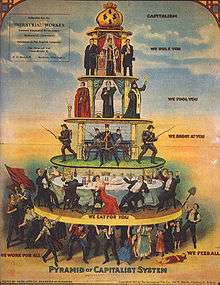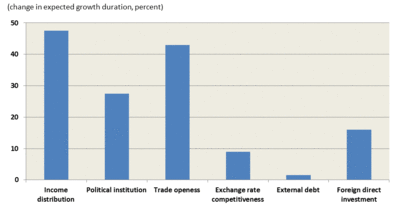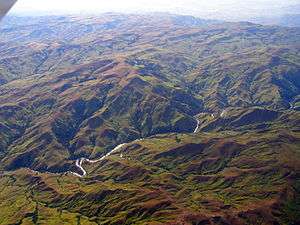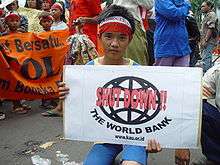Outline of globalization
| Globalization |
|---|
 |
|
|

The following outline is provided as an overview of and topical guide to the broad, interdisciplinary subject of globalization:
Globalization (or globalisation) – processes of international integration arising from the interchange of world views, products, ideas, and other aspects of culture.[1][2] Advances in transportation and telecommunications infrastructure, including the rise of the Internet, are major factors in globalization, generating further interdependence of economic and cultural activities.[3] Globalizing processes affect and are affected by business and work organization, economics, socio-cultural resources, and the natural environment.
Global studies

Global studies – interdisciplinary and multidisciplinary academic study of globalizing forces and trends. Global studies may include the investigation of one or more aspects of globalization, but tend to concentrate on how globalizing trends are redefining the relationships between states, organizations, societies, communities, and individuals, creating new challenges that cannot be solved by nations or markets alone.[4] Study of the factors contributing to globalization may originate in many academic concentrations, such as political science, economics, sociology, and many others.
History

History of globalization – generally broken-down into three periods: Archaic, Proto-globalization, and Modern.
- The Archaic period is defined as events and developments from the time of the earliest civilizations until roughly 1600.
- The period of Proto-globalization roughly spans the years between 1600 and 1800. It was largely shaped in this era by the operations of colonialism.
- The Modern period of globalization covers from the 19th century until the present time. Imperialism and industrialization have figured largely in shaping modern globalizing forces and trends.
Globalization concepts
Links below are to articles, unless otherwise specified.
Globalization-related theories
Since globalization is not an independent phenomenon but is highly interrelated with world views, products, ideas, and other aspects of culture, explanations of why globalization occurs and what the effects of globalization are or can be expected are related to theories ranging from economic development to revolutionary socialism.

- Coupled human–environment systems
- Capitalism-related
- Dependency theory
- Ecological modernization
- Economic development
- Economic nationalism
- Engaged theory
- Industrialisation
- Mercantilism
- Modernization
- Modernization theory
- New international division of labour
- Post-contemporary society
- Post-industrial society
- Postmodernism
- Primitive accumulation of capital
- Regulation theory
- Revolutionary socialism
- Sociocultural evolution
- World-systems theory
Globalization terminology
- Globalization terminology (category)
Globalization-related indices
- List of globalization-related indices
- Corruption Perceptions Index
- Democracy Index
- Global economic indicators (category)
- Freedom in the World
- Global city
- Globalization Index
Aspects of globalization
Global business organization
International business development and the organization of business and trade worldwide are fundamental aspects of globalization and the development of globalizing systems.


- Global business organization (category)
- Corporate citizenship
- Global sourcing
- Industrial ecology
- International business
- Standardization
- International trade
- Multinational companies
Economic globalization

Economic globalization – increasing economic interdependence of national economies across the world through a rapid increase in cross-border movement of goods, services, technology, and capital. International economic activities and institutions that influence or characterize economic globalization include:
- Economic globalization (category)
- Free markets
- International economics
- Global economic indicators'(category)
Sociocultural globalization
All aspects of globalization are essentially sociocultural in nature. Here, aspects of the globalization of culture are detailed, including cultural diversity, cultural homogenization and its backlash, as well as multiculturalism, multilingualism, global civics, world governance and other political developments and social movements related to globalization.



- Anti-globalization
- Criticisms of globalization
- Cultural globalization
- Democratization of technology
- Economic liberalism
- Endangered languages
- Global civics
- Global elite
- Global digital divide
- Global health
- Global inequality (category)
- Global politics
- Global village
- Globalism
- International development
- International education
- International organization
- Internet
- Multilingualism
- Pizza effect
- Race to the bottom
- Social web
- Transformation of culture
- Transnational cinema
- Transnational organized crime
- Universal Declaration of Human Rights
- Westernization
- World Englishes
- World Music Awards
- World population
- World Values Survey
Workforce globalization
Along with the globalization of business comes a new spatial division of labor, which occurs when production processes are no longer confined to national economies and labor becomes sourced from different parts of the globe. This global workforce has implications ranging from immigration policy to basic human and labor rights.


- Workforce globalization (category)
- New international division of labour
- Global labor arbitrage
- Global workforce
- Labor rights
- Offshoring
- Precarious work
- Visa policy by country (category)
Global natural environment
The natural environment can be contrasted with the built environment, comprising the areas and components that are strongly influenced by humans. In the age of globalization, few absolutely natural environments remain. Human challenges to the natural environment, such as climate change, cross-boundary water and air pollution, over-fishing of the ocean, and the spread of invasive species require at least transnational and, often, global solutions.


- Global natural environment (category)
- Environmental treaties (category)
- Biological globalization (category)
- Natural environment
- Earth system science
- Ecological economics
- Ecological imperialism
- Environmental social science
- Human ecology
- Global change
- Global commons
- Globalization and disease
- Sustainability
- Water scarcity
- World energy consumption
- World Environment Day
Globalization issues
Processes of globalization present humankind with many issues that are considered problematic in at least one culture or society, and often multiple societies.

- Global issues (category)
- Climate justice
- Economic inequality
- Fair trade
- Forced migration
- Global dimming
- Human overpopulation
- Human trafficking
- Illicit financial flows
- Invasive species
- Investor-state dispute settlement
- Global digital divide
- Global justice
- Migrant sex work
- North–South divide
- Ozone depletion
- Peace
- Race to the bottom
- Transnational organized crime
- Water issues in developing countries
- Water scarcity
- World hunger and malnutrition
- Westernization
By location
- Globalization by location (category)
- Globalisation in India
- Globalization in China
- Globalization and women in China
- Middle East and globalization
Globalization-related organizations
- Globalization-related organizations (category)
- Global environmental organizations (category)
- Global policy organizations (category)
- Intergovernmental organizations
- International nongovernmental organizations
- Global trade and professional organizations (category)
- Global workforce and labor organizations (category)
- International medical and health organizations (category)
- Social entrepreneurship (category)
Globalization-related lists
- Globalization-related lists (category)
- Lists of environmental topics (category)
- Lists of political parties by United Nations geoscheme (category)
- 2009 flu pandemic by country
- International athletics championships and games
- List of demonstrations against corporate globalization
- List of epidemics
- List of free trade agreements
- List of global sustainability statistics
- List of globalization-related indices
- List of globalization-related journals
- List of human rights articles by country
- List of human rights organisations
- List of intergovernmental organizations
- List of international rankings
- List of Occupy movement protest locations
- Lists of ecoregions by country
- Lists of endangered languages
- The Superclass List
- World economy – various embedded lists and indicators
Works about globalization
- Works about globalization (category)
- Books about globalization (category)
- Documentary films about globalization (category)
- Serials about globalization (category)
Persons influential in globalization
- Writers about globalization (category)
- Category:Anti-globalization writers
- Category:World system scholars
See also
- Civilizing mission
- Columbian Exchange
- Development criticism
- Global civics
- Great Transition
- Interdependence
- Jet Age
- Lisbon Strategy
- Military globalization
- Technocapitalism
- Transnational cinema
- Transnational citizenship
- Triadization
- Vermeer's Hat
- United Nations Millennium Declaration
- Washington Consensus
- World Englishes
References
Notes
- ↑ Al-Rodhan, R.F. Nayef and Gérard Stoudmann. (2006). Definitions of Globalization: A Comprehensive Overview and a Proposed Definition.
- ↑ Albrow, Martin and Elizabeth King (eds.) (1990). Globalization, Knowledge and Society London: Sage. ISBN 978-0803983243 p. 8. "...all those processes by which the peoples of the world are incorporated into a single world society."
- ↑ Stever, H. Guyford (1972). "Science, Systems, and Society." Journal of Cybernetics, 2(3):1–3. doi:10.1080/01969727208542909
- ↑ Harth, Chris. (2005). 'Struggling to Grasp a Moving Target: Global Studies in the US and Emergent International Landscapes.' Interim Report Prepared for Presentation at the Annual Meeting of the American Political Science Association, Washington, DC.
- ↑ "Aggregate Demand, Instability and Growth" Review of Keynesian Economics, January 2013 (see also this review of the paper)
- ↑ Berg, Andrew G.; Ostry, Jonathan D. (2011). "Equality and Efficiency". Finance and Development. International Monetary Fund. 48 (3). Retrieved September 10, 2012.
- ↑ Hardy, Roger (27 February 2008). "Migrants demand labour rights in Gulf". BBC.
Further reading
- Barbara, Christopher (2008). International legal personality: Panacea or pandemonium? Theorizing about the individual and the state in the era of globalization. Saarbrücken: Verlag Dr. Müller. ISBN 3-639-11514-7.
- von Braun, Joachim; Eugenio Diaz-Bonilla (2007). Globalization of Food and Agriculture and the Poor. Oxford: Oxford University Press. ISBN 978-0-19-569528-1.
- Carpenter, John. "Puritan Missions as Globalization," Fides et Historia. 31:2, 1999 pp. 103–123.
- Chanda, Nayan (2007). Bound Together: How Traders, Preachers, Warriors and Adventurers Shaped Globalization. Yale University Press, New Haven. ISBN 978-0-300-11201-6.
- Fernando, Salvetti (ed.) (2010). "Glocal" Working. Living and Working across the World with Cultural Intelligence. Milan: Franco Angeli. ISBN 978-88-568-2733-0.
- Glyn, Andrew (2006). Capitalism Unleashed: Finance, Globalization, and Welfare. Oxford: Oxford University Press. ISBN 0-19-922679-2.
- Kitching, Gavin (2001). Seeking Social Justice through Globalization. Escaping a Nationalist Perspective. Penn State Press. ISBN 0-271-02162-4.
- Kohler, Gernot; Emilio José Chaves, eds. (2003). Globalization: Critical Perspectives. Hauppauge, New York: Nova Science Publishers. ISBN 1-59033-346-2. With contributions by Samir Amin, Christopher Chase-Dunn, Andre Gunder Frank, Immanuel Wallerstein
- Mander, Jerry; Edward Goldsmith (1996). The case against the global economy: and for a turn toward the local. San Francisco: Sierra Club Books. ISBN 0-87156-865-9.
- Moore, Karl; David Charles Lewis (2009). Origins of Globalization. New York: Routledge. ISBN 978-0-415-80598-8.
- Murray, Warwick E. (2006). Geographies of Globalization. New York: Routledge. ISBN 0-415-31799-1.
- Neumann, Iver B.; Ole Jacob Sending (2010). Governing the Global Polity: Practice, Mentality, Rationality. Ann Arbor: University of Michigan Press. ISBN 978-0-472-07093-0.
- Osterhammel, Jürgen; Niels P. Petersson (2005). Globalization: A Short History. Princeton, New Jersey: Princeton University Press. ISBN 0-691-12165-6.
- Pfister, Ulrich (2012). Globalization. Mainz: Institute of European History,.
- Reinsdorf, Marshall and Matthew J. Slaughter (2009). International Trade in Services and Intangibles in the Era of Globalization. Chicago: The University of Chicago Press. ISBN 978-0-226-70959-8.
- Sen, Amartya (1999). Development as Freedom. Oxford, New York: Oxford University Press. ISBN 0375406190.
- Sirkin, Harold L; James W. Hemerling; Arindam K. Bhattacharya (2008). Globality: Competing with Everyone from Everywhere for Everything. New York: Business Plus. p. 292. ISBN 0-446-17829-2.
- Smith, Charles (2007). International Trade and Globalisation, 3rd edition. Stocksfield: Anforme. ISBN 1-905504-10-1.
- Steger, Manfred (2002). Globalism: the new market ideology. Lanham, Maryland: Rowman & Littlefield Publishers. ISBN 0-7425-0072-1.
- Stiglitz, Joseph E. (2002). Globalization and Its Discontents. New York: W.W. Norton. ISBN 0-393-32439-7.
- Stiglitz, Joseph E. (2006). Making Globalization Work. New York: W.W. Norton. ISBN 0-393-06122-1.
- Tausch, Arno (2008). Multicultural Europe: Effects of the Global Lisbon Process. Hauppauge, New York: Nova Science Publishers. ISBN 978-1-60456-806-6.
- Tausch, Arno (2015). The political algebra of global value change. General models and implications for the Muslim world. With Almas Heshmati and Hichem Karoui. (1st ed.). Nova Science Publishers, New York. ISBN 978-1-62948-899-8.
- Osle, Rafael Domingo (2010). The New Global Law. Cambridge: Cambridge University Press. ISBN 9780521193870.
- Wolf, Martin (2004). Why Globalization Works. New Haven: Yale University Press. ISBN 978-0-300-10252-9.
External links
- Comprehensive discussion of the term at the Site Global Transformations
- Globalization Website (Emory University) Links, Debates, Glossary etc.
- BBC News Special Report – "Globalisation"
- "Resilience, Panarchy, and World-Systems Analysis", from the Ecology and Society Journal
- "Globalization" Stanford Encyclopedia of Philosophy Analysis of the idea and its history.
- OECD Globalization statistics
- "Globalization", from The Canadian Encyclopedia
- YaleGlobal Online
- Global 3000 Globalization Program by Deutsche Welle-TV

